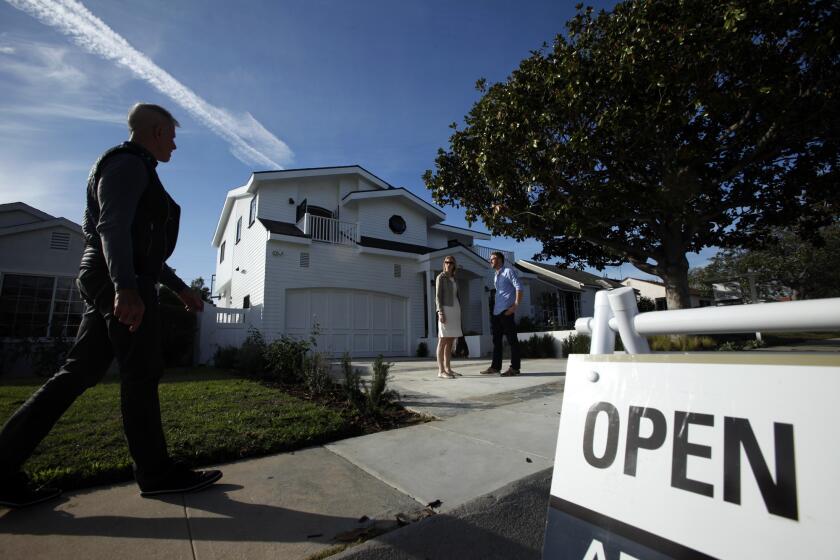How freelancers can get around a new mortgage-refinancing obstacle
- Share via
Homeowners can permanently cut one of their biggest monthly expenses by refinancing at today’s historically low rates. But there’s a new refinancing challenge for freelancers: You’ve got to prove that your income hasn’t been savaged by the pandemic.
Lenders are turning away freelancers and small-business owners who have lost clients or projects during the last four economically challenging months, mortgage experts say. The new rules haven’t made refinancing impossible for freelancers, but they have made it dramatically more difficult.
“Lenders used to simply require a current-year tax return to verify self-employment income,” said Steven Foster, owner of Pasadena mortgage brokerage Vista Financial Advisors. “Now you need to show bank statements for the past two months to prove that your income hasn’t been hurt.”
If it has, you may need to jump through hoops to get qualified based on assets or a low debt-to-income ratio.
Is it worth it?
Refinancing can be a hassle even under the best of circumstances. Knowing that it might be tougher now could cause you to wonder whether it’s worth it. The answer will hinge on your current interest rate and the size of your loan.
If you currently have a 30-year, fixed-rate loan at 4%, for instance, your monthly payment would work out to $477.42 for each $100,000 that you originally borrowed. In other words, if your loan was for $500,000, your monthly payment would be $2,387.08 (5 times $477.42).
Borrowers with good credit can now get a 30-year, fixed-rate loan at 2.75%. That would cut the monthly payment to $408.24 per $100,000 balance, or $2,041.21 on a $500,000 loan. That’s a monthly savings of nearly $346. Over the course of a 30-year loan, the savings works out to more than $124,500 — well worth a little inconvenience.
Practical refinance math
Of course, the previous example holds balances and repayment terms constant to provide an apples-to-apples comparison.
In reality, if you have a 4% loan, you’ve probably been paying on your mortgage for a decade. Your balance might have fallen to, say, $400,000. And you may not want to add years onto your repayment schedule by refinancing.
Is a refinance still beneficial? Assuming you refinance your current balance into a 20-year loan at 2.75%, your monthly payments work out to $542.17 per $100,000 borrowed. That’s $2,168.67 — a $218.41 monthly savings over the existing 4% loan. That saves more than $52,400 in interest expenses over the 20-year life of the agreement.
Crunch your numbers
Want to see how this works with your loan? You can play with your own numbers by using the multipliers in the chart below. To estimate a monthly payment at any given interest rate, round your loan amount to the nearest thousand dollars. In other words, if you owe $175,250, round to $175 and multiply that by the multiplier that most closely corresponds with your interest rate.
For example, if you qualify for a 5%, 30-year loan, you’d multiply $175 by 5.37 to get an estimated monthly payment of $939.75. You’d use the 7.91 multiplier if you preferred a 15-year loan at 5%. (Because we’re rounding, your real numbers will be close but not precise. In this case, for instance, the actual monthly payment for a 30-year loan would work out to $940.78.)
Interest rate...30-year...15-year
5.00% .............5.37...........7.91
4.75%..............5.22...........7.78
4.50%..............5.07...........7.65
4.25%..............4.92..........7.52
4.00%..............4.77..........7.40
3.75%..............4.63..........7.27
3.50%..............4.49..........7.15
3.25%..............4.35..........7.03
3.00%..............4.22..........6.91
2.75%..............4.08..........6.79
2.50%..............3.95..........6.67
2.25%..............3.82..........6.55
2.00%..............3.70..........6.43
Refinancing challenge for freelancers
If applying the math convinced you that you should refinance, here’s the challenge for freelancers. The Federal National Mortgage Assn., better known as Fannie Mae, has new rules that dictate how lenders must assess a self-employed borrower’s ability to repay. (Fannie Mae buys loans from lenders, so most lenders follow its rules.)
The pre-COVID-19 rulebook let banks verify income by simply looking at the borrower’s most recent tax return, but Fannie Mae now requires that lenders also look at the borrower’s cash flow since the beginning of this year. Lenders must take particular note of business income during the last 60 days.
If that income is less than the income reflected on the borrower’s tax return for the same period last year, the lender needs to go through a number of other checks to determine whether the borrower can still qualify for a loan.
Unemployment benefits are not counted as income, except for seasonal workers.
Options
If your income has declined, there are still two ways that you may be able to qualify for a new mortgage, says Foster, the mortgage brokerage owner.
One way is to have the lender look at your current debt-to-income ratio. If that ratio is under 50%, even with your current income, you could still qualify for the loan.
How do you calculate your debt-to-income ratio? You look at the minimum payments required on all of your outstanding loans — student loans, credit cards, car loans and mortgages. Add up the minimum payments and then compare the total to your gross income. If you have minimum monthly payments of $1,000 on a mortgage; $250 on a car loan, $100 on student loans and $150 on credit cards, for example, the total amounts to $1,500. As long as your monthly income exceeds double that amount — in this case, $3,000 — you have a debt-to-income ratio below the required 50%.
You may still have to explain your business plan to assure the lender that the $3,000 in monthly income you’re receiving now is solid. But at least your loan application won’t be rejected out of hand.
For those with plenty of savings, there’s a second option — one that factors in “asset depletion,” Foster says. This loan underwriting process looks at the other assets that the borrower has available and determines whether the borrower can repay the loan by simply “depleting” their other assets over time. Retirement assets are generally not used in this calculation unless the borrower is old enough to tap them without penalty, he says.
Moreover, unless your assets are in cash — bank accounts and money-market funds — the lender will impose a 30% “discount” against your assets before determining what you can afford. So if you had $500,000 in noncash savings, the lender would assume you had only $350,000 to pay off the loan. That’s to protect from market swings, Foster says.
“In other words, if you don’t really need a loan, you can get a loan,” he says.
Different from 2009
It’s worth noting that in 2009, during the last recession, mortgage rules were altered by the Home Affordable Refinance Program, better known as HARP. The program essentially enabled economically troubled homeowners to refinance their existing loan balances to reduce their interest rates but did not let them add debt.
“All you were doing is helping borrowers improve their position by reducing the interest rate and required payment on the loan,” said David Battany, executive vice president of capital markets with Guild Mortgage in San Diego.
The HARP program expired and no similar program has been initiated to cope with the current recession. Now, even when borrowers have a long track record of making higher mortgage payments, they may not be able to qualify for a new reduced-rate mortgage, experts say.
“It just doesn’t make sense,” Battany complains. “Whatever hole a person is in because of COVID, why wouldn’t you let them improve their position by saving money on their mortgage payments?”
The federal CARES Act passed this year does provide some mortgage relief for those who are temporarily unable to make payments. However, there is no provision specifically allowing troubled homeowners to refinance to lower rates the way they could under the HARP program. The benefit of a refinance, rather than a temporary payment hiatus, is that your payments lock in at a lower rate for the life of the loan.
Mortgage companies are letting home owners with coronavirus-related financial hardships delay payments, but the process is confusing
Time is on your side
While those challenges may appear daunting, there’s no reason to believe that interest rates are going to climb in the next few months.
That gives you some time to ramp up your efforts to possibly bring in enough additional income to meet today’s exacting business-income requirements.
What if your industry is still languishing? You might consider a side hustle in some of the industries that continue to thrive.
Those who can teach or tutor, for instance, can find well-paid jobs with dozens of online tutoring platforms. Realize, too, that tutoring isn’t limited to academic subjects. Some sites that enlist freelancers as tutors, such as Lessonface, specialize in art, music and language. Others focus on technology and coding.
There is also strong demand for babysitters, writers, consultants and virtual assistants.
If you’re not afraid to work in the public, consider that delivery services such as DoorDash and Grubhub are seeing high demand from customers. Even Uber and Lyft drivers report that they’re earning more today, largely because fewer people are willing to drive.
If you’re not certain what you can do, take the SideHusl Quiz, which attempts to match people with side hustles that suit their unique combination of skills, interests and resources.
Kristof is the editor of SideHusl.com, an independent site that reviews hundreds of money-making opportunities in the gig economy.
More to Read
Inside the business of entertainment
The Wide Shot brings you news, analysis and insights on everything from streaming wars to production — and what it all means for the future.
You may occasionally receive promotional content from the Los Angeles Times.











